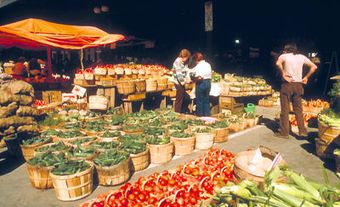
Cider, an alcoholic beverage made from fermented apple juice, was the drink of choice for early settlers in North America. During the 17th and 18th centuries, it was believed that water was the source of several diseases and therefore not safe to drink. Fermented, low-alcohol beverages were consumed instead — even by children, who drank them in diluted form. Hardy apple trees grew easily and in abundance, providing the means to press juice.
Hard Cider in Canada: The Pioneer Days
Settlers brought saplings and apple seeds from France and England, carrying heirloom cider and dessert apples across the ocean. But when apple seeds fall to the ground, the new tree doesn’t produce the same kind of apple variety. Instead, apples are “extreme heterozygotes,” which means that each tree planted from seed (rather than grafted) will produce unique and unpredictable fruit — often only distantly related to their parent DNA.
These apples provided the juice for some of Canada’s first hard ciders. It is estimated that the country’s earliest cidery (i.e., a brewery where cider is produced) was established in the mid to late 17th century, on Mont Royal in New France, by Sulpician priests who planted an orchard and erected a cider mill. Outside of major settlements, cider was a farmhouse drink: besides apples, settlers would add raisins, molasses and other sugars to up the alcohol content, sometimes maturing the cider in spare rum or port barrels.
At this time, all ciders were “hard” ciders (i.e., alcoholic). Non-alcoholic cider and apple juice were produced during the Temperance Movement and through the Prohibition era — and grew in abundance when refrigeration was introduced in the early 1920s.
As more people settled in cities during the Industrial Revolution (1760–1850), cider production dropped. Cider must be produced near to orchards and it was expensive to transport apples to expanding urban centres for production. Also, cider does not keep well over time. Beer, however, can be brewed in the city, partly because barley is easier to transport without spoilage.
Such rough economics and changing tastes led beer to become the drink of choice and cider to fall out of favour. More and more sweet apples were cultivated for dessert and culinary purposes, while the bitter apples that possessed tannins and astringents that make good cider were weeded out. Social factors, including the rise of the Temperance movement in the late 1800s, and ultimately the Prohibition era (late 1800s to 1920) finally ended the mass production of cider.
Cider Revival
Early settler-style cider — even contemporary craft cider — differs from today's mass-produced ciders. Craft ciders are made exclusively from fresh pressed apple juice, while mass-produced ciders are made using mostly apple concentrate with a small amount of pressed apple juice and additional sugars, which vary from brand to brand.
Artisanal ciders made a comeback nearly 100 years after Canada’s cider-making heritage was crushed — a re-emergence that was driven by an interest in local-food and a thirst for craft drinks. The small-batch makers at the heart of the boom adopted the same experimental approach to cider making as the early settlers.
Québec: Beginning of the Boom
When the Québec Liquor Commission was established in 1921, hard cider was overlooked on the bill that covered the sale and production of alcoholic beverages, making it illegal to produce and sell cider in Québec for nearly 50 years. The blunder was corrected in the 1970s, but those early commercial ciders were made with inferior apples and had a sour taste.
It took some time for customers to come back to cider. It wasn’t until the early 1980s that such renowned cider-makers as Michel Jodoin of Cidrerie Michel Jodoin, and Robert Demoy of Cidrerie du Minot, gained recognition for their products.
Cidre de glace, or ice cider, was first brewed by Christian Barthomeuf in 1989 in the Eastern Townships of Québec. Barthomeuf worked as the cider maker for industry leaders Domaine Pinnacle and Face Cachée de la Pomme — who together hold nearly 80 per cent of the Québec cider market — until he launched his own cider, Clos Saragnat, in 2002.
The majority of Québec’s 73 cideries brew at least one ice cider, which has a higher content of alcohol by volume than other ciders and can be sweet, tart or dry in flavour. Modeled on ice wine, ice cider is made from frozen apples harvested in the fall or winter, which have a high concentration of sugars, producing a sweet, syrupy and higher-alcohol dessert drink. They take several months to ferment.
Producers of ice cider are often small, family-run outfits such as Charles Crawford and his wife, Susan Reid, Montréalers who stumbled on an apple orchard in the countryside near Vermont in 2000 and bought the place. Their cidery, Domaine Pinnacle, would garner over 100 international awards by 2013 for its ice, still and sparkling ciders.
The Artisan Cider Producers of Québec are an industry association that stipulates that an “artisanal cidery” must be an agricultural producer and use apples from its own orchards in its cider and must make ice cider on-site. As of 2014, there were at least 60 permitted artisanal cideries in Québec.
Cider Making in Ontario, British Columbia and Eastern Canada
The cider tradition is even younger in the rest of Canada, where most outfits began sprouting in the apple belts of Nova Scotia, Ontario and British Columbia in the early 2000s. These new cideries look to English, Norman and early North American cider traditions for inspiration.
John Brett, a film editor and cider lover, partnered with farmer Andrew Bishop to start Tideview Cider in the Annapolis Valley of Nova Scotia in 2005. Brett researched the apple varieties that were favoured for cider production along the eastern seaboard from Delaware to Nova Scotia during the Colonial period. “Very few of them were traditional English cider apples, which are great for adding tannins, but not great for much of anything else,” he said. “In North America, there wasn’t that same degree of divergence between a multi-purpose apple and cider-specific apples. But we did favour certain varieties for cider like Golden Russet and Ribston Pippin.” Tideview grows and uses these and other heirloom varietals blended with wild crab apples.
Besides a few private orchards, North American heirloom and Old World apple varietals — which are sour, acidic and tannic rather than the more common sweet dessert apples — have been hard to find for Ontario, British Columbia, and Nova Scotia’s cider industries. A 2013 Economic Impact Study commissioned by the Ontario Craft Cider Association (OCCA) predicted that craft cider sales would continue as one of the fastest growing categories at the Liquor Control Board of Ontario, with sales rising from $1.13 million in 2013 to $35 million by 2018. Those numbers were expected to influence the decisions made by apple growers. When the OCCA formed in 2012 it accounted for seven cider producers. By 2014, the OCCA had 16 members, representing all Ontario cider producers selling product to the public. Some wineries also produce small batches of cider, which they sell in their own store; they are not counted as part of the 16 cider producers with the OCCA.
British Columbia’s oldest working cidery, Growers Cider Company, opened as Growers Wine Company in 1927 in Saanich, BC on Vancouver Island . Across the Saanich inlet, Victoria’s Sea Cider Farm and Ciderhouse is also well-known. As of 2014, British Columbia had at least 14 cideries.
Borrowing from Craft Beer
Many cider makers have taken the lead from craft brewers in Canada, many of which started operations by renting brew tanks in larger breweries before investing in their own equipment.
British-born Chris Haworth launched the Toronto-based West Avenue Cider in 2013 without a cidery and without an orchard. In 2006, he noticed the dearth of artisanal cider in Ontario and spotted an opportunity. By 2013, he had quit his job as a head chef and rented space from Pommies Dry Cider in Caledon.
Haworth ages ciders in everything from Niagara Merlot to Bourbon barrels, and ferments using beer, wine, wild and champagne yeasts. In December 2013, he took over the taps at Momofuku Noodle Bar in Toronto, pouring custom cider made with pear, shiso, yuzu, ginger, amazake, and a sake yeast.
Canada’s emerging craft cideries make products where fresh-pressed apple juice makes up 80 to 100 percent of the cider. Cideries outside of Québec do not receive the same tax breaks as craft breweries or local wineries, making it impossible to compete with such commercial imports as Magners or larger craft brands such as Angry Orchard. Cider associations are lobbying government to change this.

 Share on Facebook
Share on Facebook Share on X
Share on X Share by Email
Share by Email Share on Google Classroom
Share on Google Classroom


